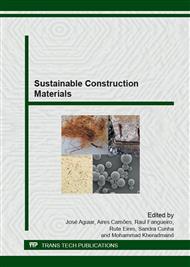[1]
PERTLIK, F.; ROGER, J.J.N.; ADAMS, J.A.S. Uranium. In: WEDEPOHL, K.H. (Ed. ) Hsndbook of Geochemistry. Berlim: Springer Verlag, 1974. p.92. 0192. 08.
Google Scholar
[2]
MOREIRA & NORDEMANN, L. M. 1977. Etude de la vitesse d'alteration des roches au moyer de l'uranium utilize comme traceur natural. Application a deux bassins du nordest Du Bresil, Paris, 1977. 162 p. Tese (doctorat d' État). Université Pierre et Marie Curie.
Google Scholar
[3]
BINNS, D. C. A. Radon concentration in Brazilian environments: preliminary data. In: Congresso Brasileiro de Geofísica, 1, 1995. Rio de Janeiro. Resumos … Rio de Janeiro.
Google Scholar
[4]
EPA - UNITED STATES ENVIRONMENTAL PROTECTION AGENCY. 2003. Assessment of Risks From Radon in Homes. 99f. Washington, DC, Junho (2003).
Google Scholar
[5]
ABIROCHAS - ASSOCIAÇÃO BRASILEIRA DA INDÚSTRIA DE ROCHAS ORNAMENTAIS, 2008. Radioatividade Natural em Materiais Rochosos. Informe 18/2008. Disponível em: www. abirrochas. com. br. Acesso em: 13/07/(2011).
Google Scholar
[6]
MURPHY, KATE. What's Lurking in Your Countertop? The New York Times. Published: July 24, 2008. Disponível em: http: /www. nytimes. com/2008/07/24/garden/24granite. html?pagewanted=1&_r=1&sq=radon&st=cse&scp=1. Acesso em: 31/05/(2011).
Google Scholar
[7]
SANTOS, C. E. L. 2008. Determinação dos Processos de Enriquecimento e das Concentrações de Radônio em Minas Subterraneas de Fluorita e Carvão do Estado de Santa Catarina: Critério para Avaliação dos Riscos Radiológicos. 137f. Dissertação (Mestrado), Universidade do Rio Grande do Sul, Porto Alegre – RS, (2008).
DOI: 10.32467/issn.2175-3628v23n1a14
Google Scholar
[8]
CHEN, J. 2005. A Review of Radon Doses. pp.27-31. Radiation Protection Management. Volume 22, No. 4, (2005).
Google Scholar
[9]
ICRP - INTERNATIONAL COMMISSION ON RADIOLOGICAL PROTECTION. 1993. Protection against radon at home and works. Oxford: ICRP Publ, v. 23, n. 2, 65f. (1993).
Google Scholar
[10]
ABNT - ASSOCIAÇÃO BRASILEIRA DE NORMAS TÉCNICAS. 1992. NBR 12. 766: Rochas para revestimento – Determinação da massa espécifica aparente, porosidade aparente e absorção d'água aparente. São Paulo, (1992).
DOI: 10.4322/tmm.2014.046
Google Scholar
[11]
FRAZÃO, E. B. & FARJALLAT, J. E. S. 1995. Características Tecnológicas das principais rochas silicáticas brasileiras usadas como pedras de revestimento. Atas do 1º Congr. Internacional da Pedra Natura. Lisboa, Portugal, 1995. 47-58p.
Google Scholar
[12]
DUARTE, R. M. 2002. Radioelementos naturais na área do projeto Rio Preto (GO). 2002. 169 f. Tese (Doutorado), Universidade Estadual Paulista, Rio Claro-SP, (2002).
Google Scholar
[13]
SALAS, H.T.; NALINI JR., H.A.; MENDES, J.C. 2003. Radioatividade em rochas ornamentais do Brasil. Anais IV Simp. de Rochas Ornamentais do Nordeste. (Eds: F.W.H. Vidal e M. AA.B. Lima; Rio de Janeiro: CETEM/SBG, 2003). pp.68-73. Fortaleza – CE, (2003).
DOI: 10.12957/tamoios.2014.7858
Google Scholar
[14]
AMARAL, P. G. Q., GALEMBECK, T. M. B., BONOTTO, D. M., ARTUR, A. C. 2012. Uraniun distribution and radon exhalation from Brazilian dimension stones. Applied Radiation and Isotopes. 70: 808-817.
DOI: 10.1016/j.apradiso.2011.10.010
Google Scholar
[15]
ARTUR, A. C., BONOTTO, D. M., AMARAL, P. G. Q., GALEMBECK, T. M. B. 2013. Metodologia para a quantificação da exalação do gás radônio em rochas ornamentais. Geociências, São Paulo, v. 32, n. 1, pp.166-180.
DOI: 10.11606/t.102.2017.tde-23012017-093147
Google Scholar
[16]
WANTY, R. B.; LAWRENCE, E. P.; GUNDERSEN, L. C. S. 1992. A theoretical model for the flux of radon from rock to groundwater. In: Gattes, A. E. & GUNDERSEN, L. C. S. eds. Geologic controls of radon. Boulder, Colorado.
DOI: 10.1130/spe271-p73
Google Scholar
[17]
BONOTTO, D. M. & ANDREWS, J. N. 1997. The implications of laboratory 222Rn flux measurements to the radioactivity in groundwaters: the case of a karstic limestone aquifer. Applied Geochemistry; 12: 715-726.
DOI: 10.1016/s0883-2927(97)00040-1
Google Scholar
[18]
P.G. Clem, M. Rodriguez, J.A. Voigt and C.S. Ashley, U.S. Patent 6, 231, 666. (2001).
Google Scholar
[18]
MOURA, C. L. Radioatividade natural e emanação de ²²²Rn em rochas ornamentais provenientes de diferentes séries magmáticas utilizadas como revestimento interno. 2005. 195 f. Tese (Doutorado), Universidade Estadual Paulista, Rio Claro-SP, (2005).
Google Scholar
[19]
CHYI, L. L. 2008. Radon Testing of Various Countertop Materials Final Report. 15 f. The University of Akron, Maio, (2008).
Google Scholar


